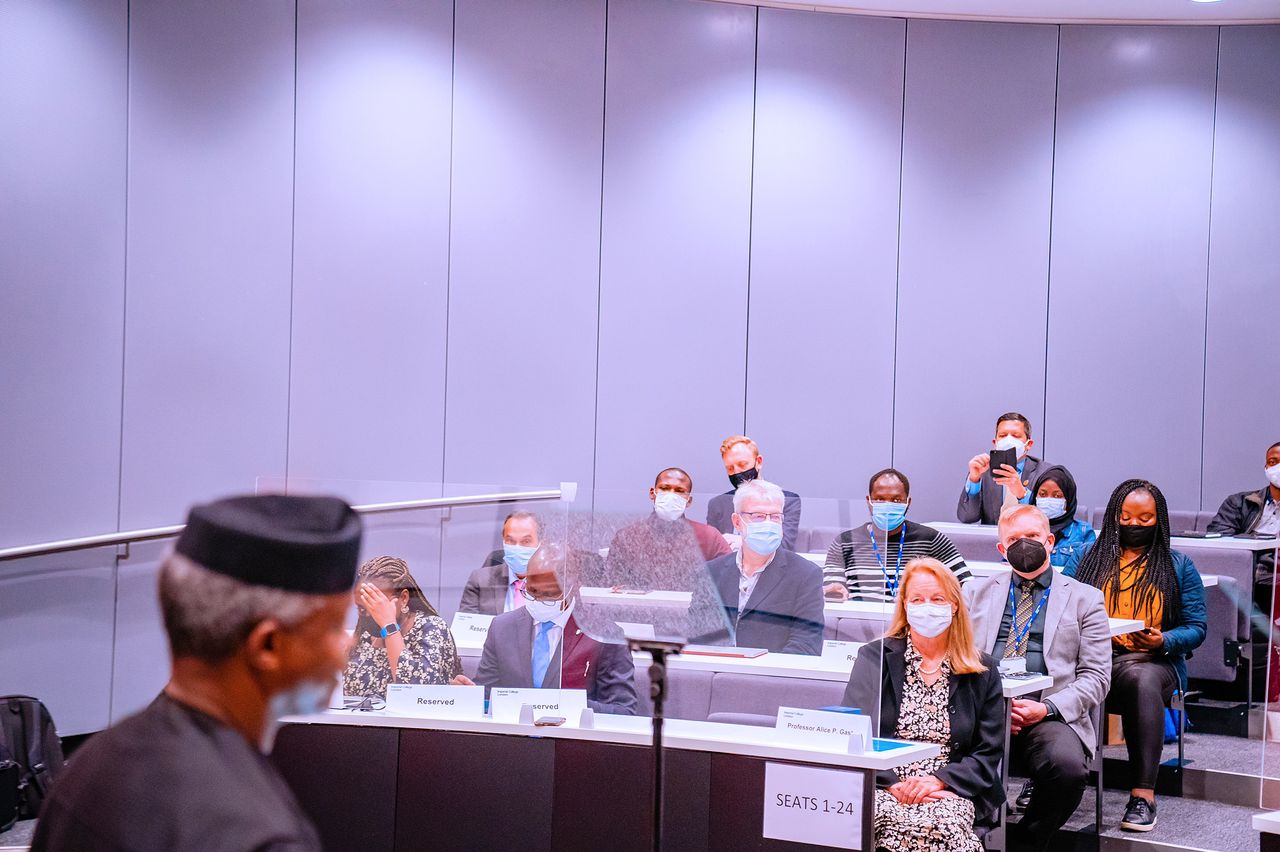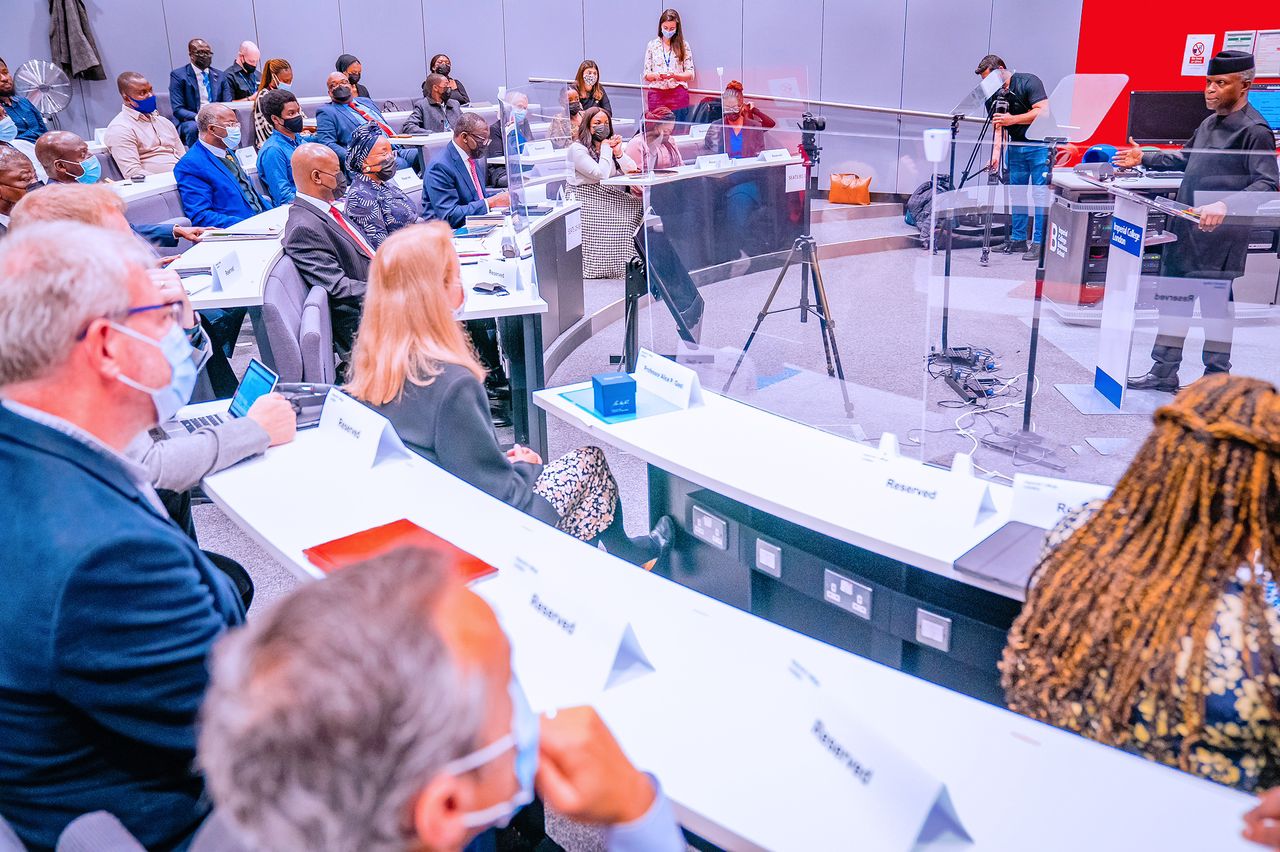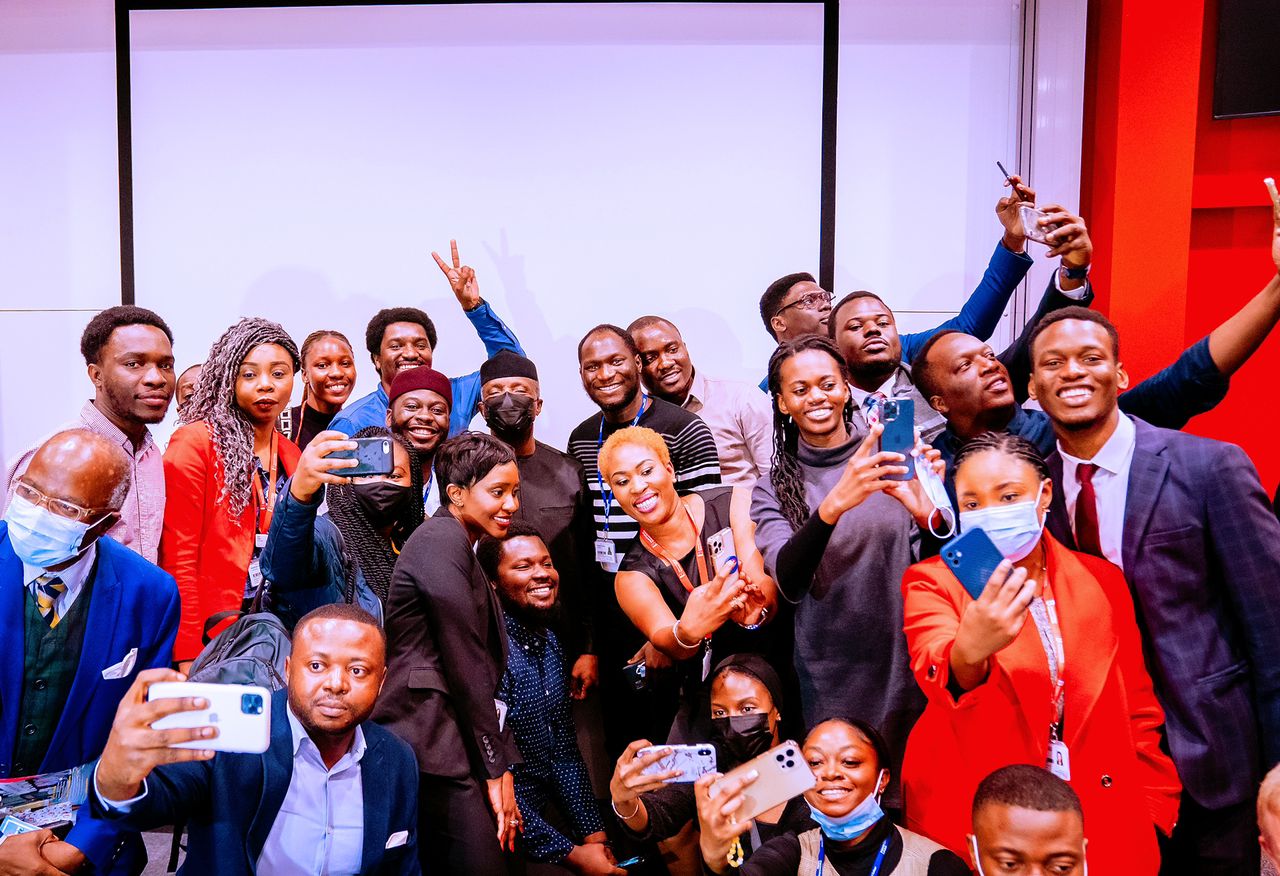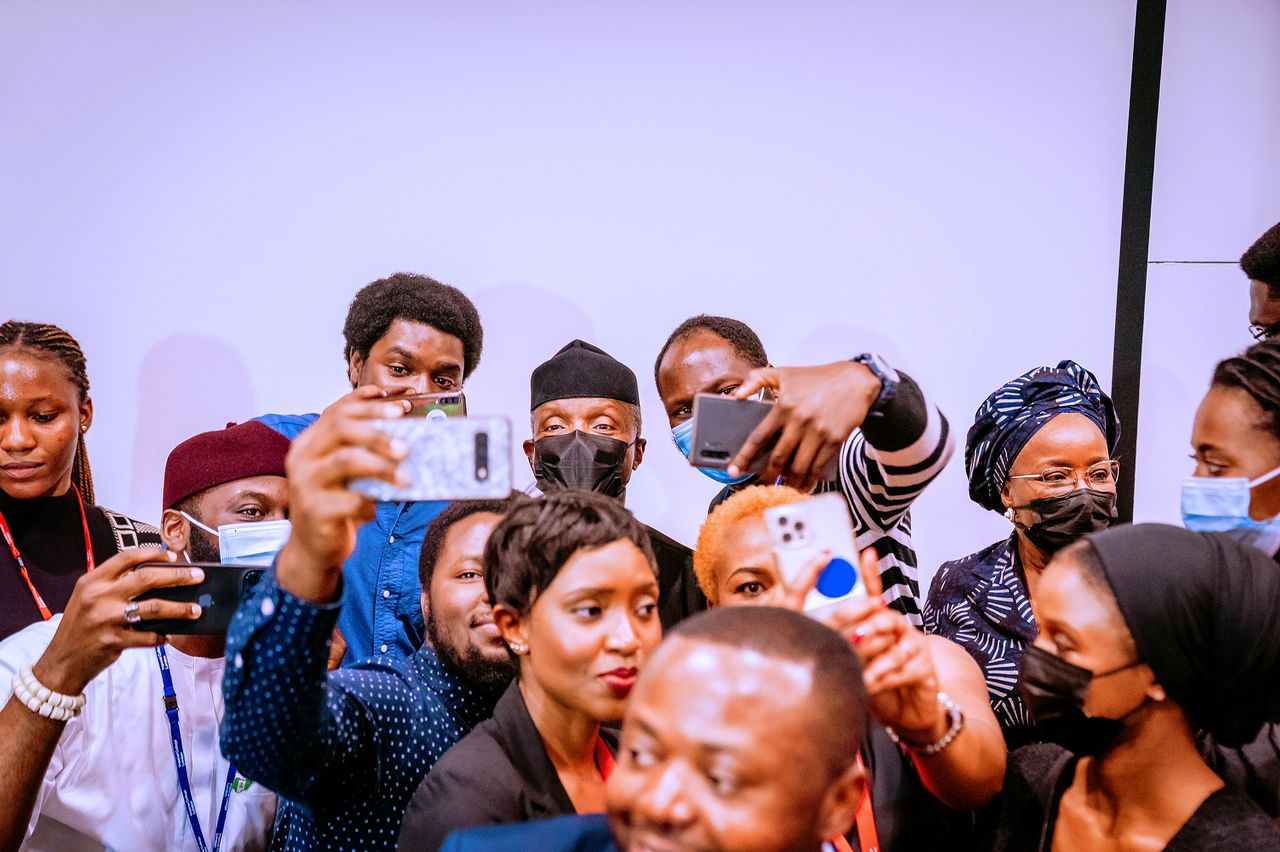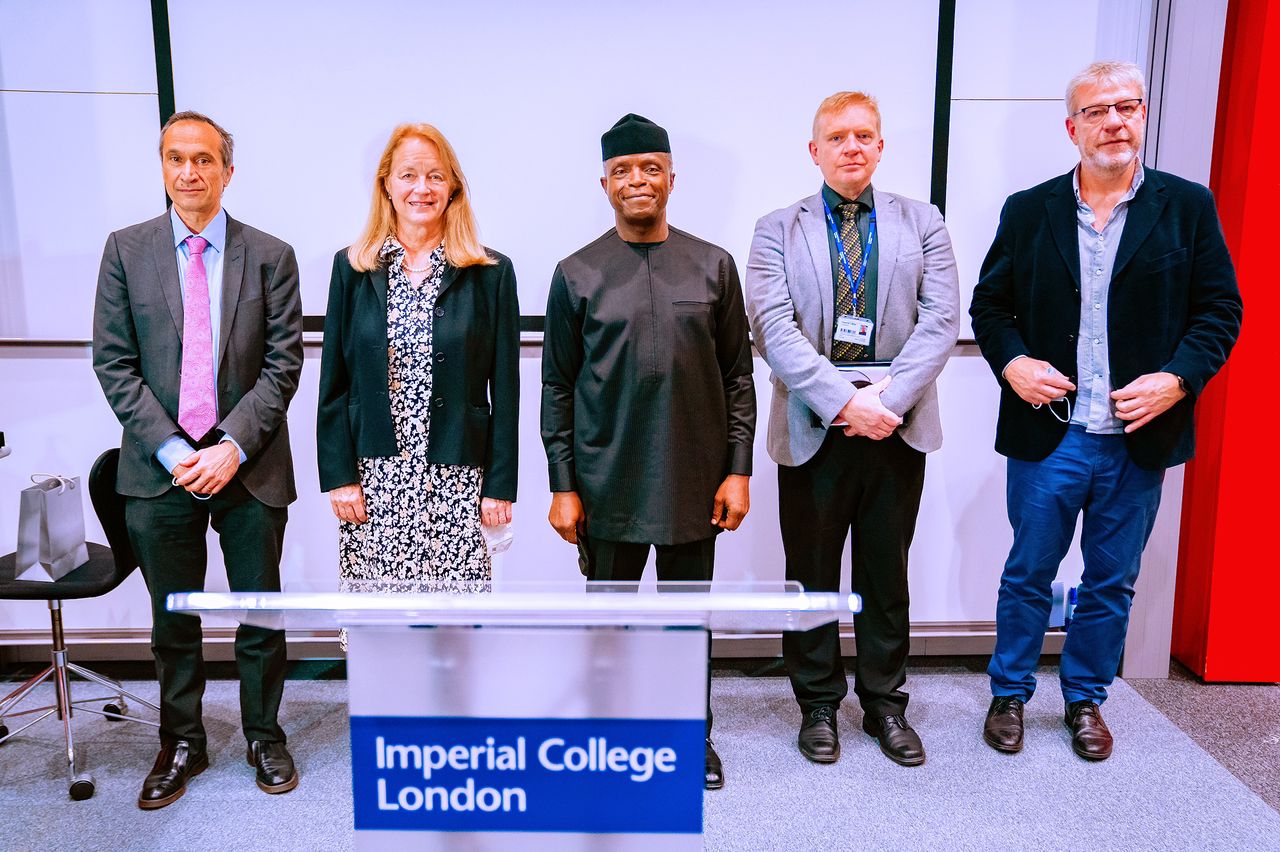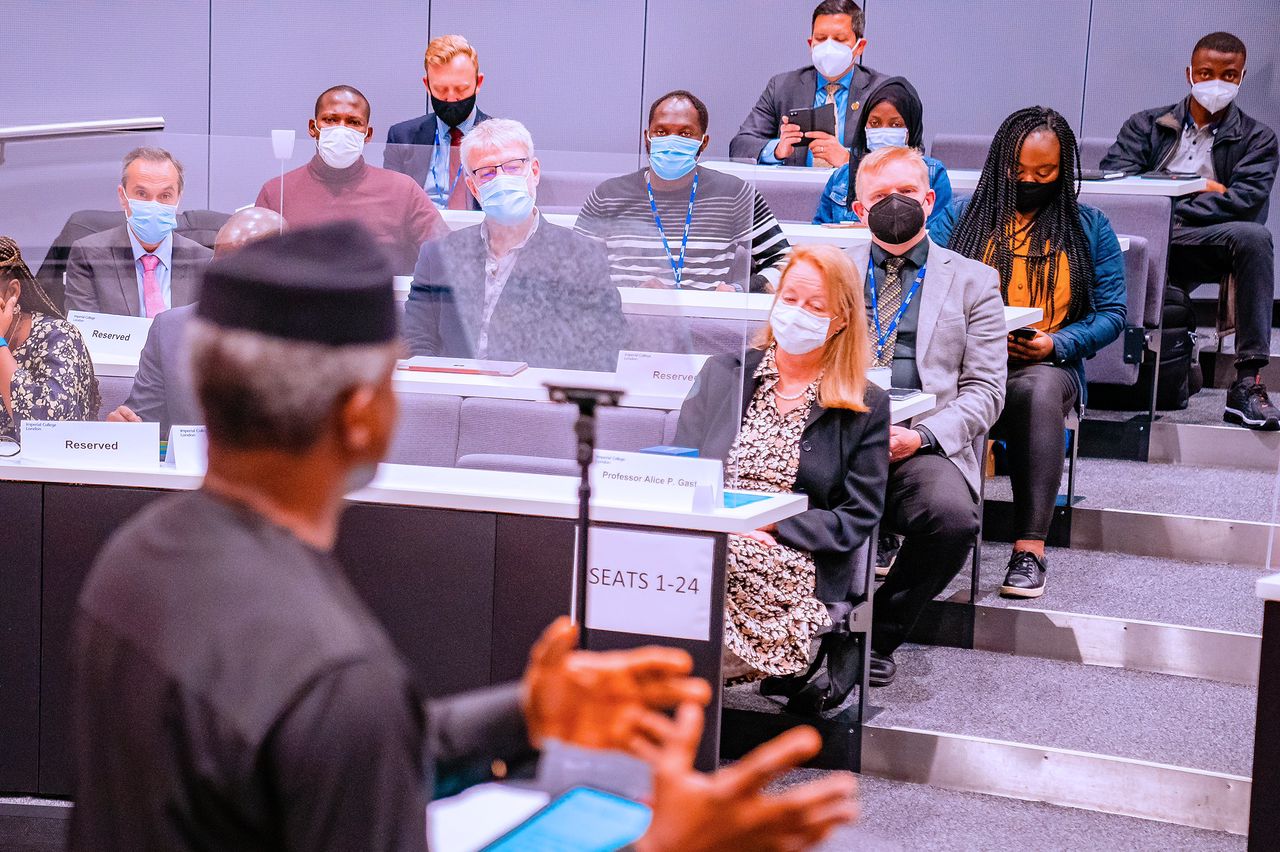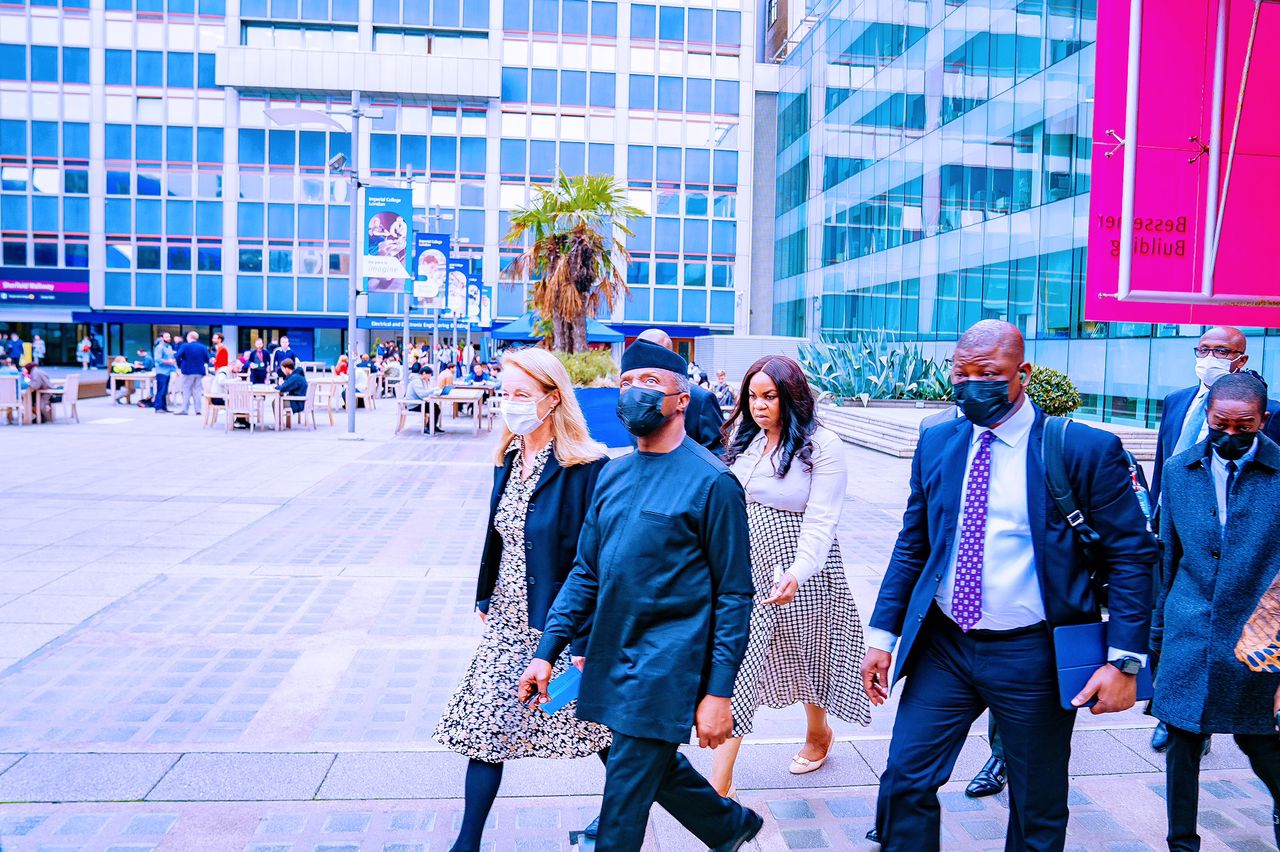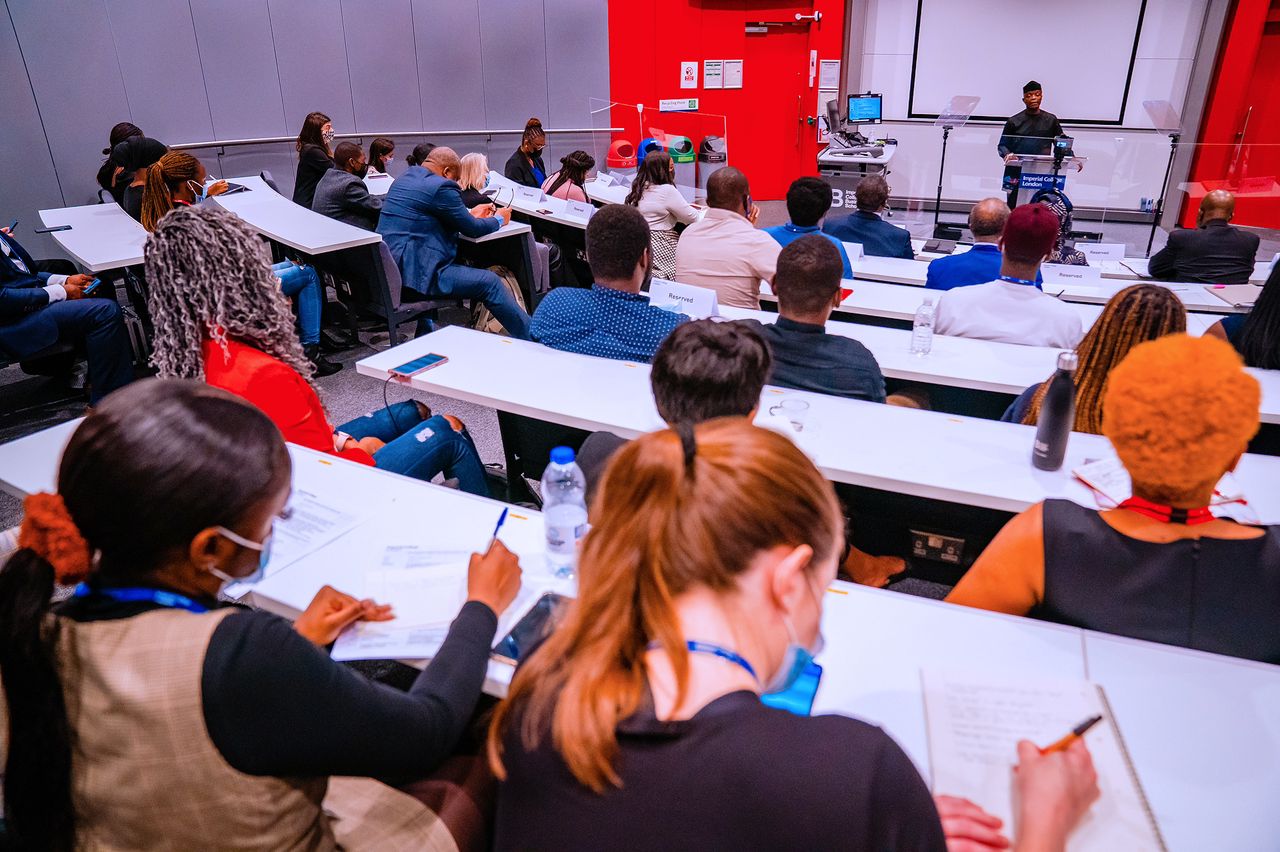Imperial College/UN High-Level Energy Dialogue On A Just And Equitable Transition
SPEECH BY HIS EXCELLENCY, PROF. YEMI OSINBAJO, SAN, GCON, VICE PRESIDENT OF THE FEDERAL REPUBLIC OF NIGERIA AT UN HIGH-LEVEL ENERGY DIALOGUE ON A JUST AND EQUITABLE TRANSITION AT IMPERIAL COLLEGE, LONDON ON THE 8TH OF OCTOBER, 2021
PROTOCOLS
I thank you so much for the great work going on the Climate Compatible Growth and the International Calculator Programme, as well as the Energy Transition Offer. This is the work that we really must, perhaps even at a much higher level, integrate with what we are trying to do at the moment, and as you’ve pointed out, we have very little time to achieve all that we need to do as the world gets warmer.
I would like to thank the management of Imperial College for being such gracious hosts and for the warm hospitality extended to me and my team since we arrived.
This is the second time that we are collaborating with Imperial College and the first is with the one led by Prof. Leslie Drake of the Department of Infectious Epidemiology, who are our technical partners in the Partnership for Child Development, and this is a home-grown school feeding programme, where we have been, in the past four and a half years, feeding about 10.4 million children in public schools daily. The partnership is very important and I would just want to thank Imperial College for providing the facilitation for making all that possible.
I am going to be speaking for a few minutes on a just energy transition programme and just to begin by emphasizing the obvious, we are confronted with a climate crisis of an incredible dimension, we must take the threat seriously and in doing so, we must work hard towards limiting global warming to 1.5 degrees Celsius from pre-industrial levels, and net-zero by 2050.
Second is that the transition to our objective, net-zero emissions by 2050 is, at least for developing countries, and the poor in wealthier countries, as important as the objective itself. The process is as important as the objective. Developing countries unlike the rest of the world, have two, not one, existential problems.
Aside from the climate crisis, we have of problem lifting millions out of extreme poverty and its implications for disease, malnutrition, and premature mortality. And access to energy is a huge part of that.
So, just as the world has made commitments to reduce global warming, it has also agreed to 17 sustainable development goals that are built on a critical principle of leaving no one behind. In addition, sustainable development and poverty eradication are enshrined in relevant global treaties including the Paris Agreements. This is why our energy transition plans must be equitable, inclusive, and just – a planet and people approach to the transition.
As a practical matter, this means transition plans that take into account the different realities of various economies and accommodate various pathways to net-zero by 2050. For us, the process of getting to net-zero and development and ensuring we are able to lift millions out of poverty must be thought of together.
For us, the process is as important as the objective, the transition is as important as getting to net-zero. The transition has to be fair and balanced and if we don’t have one that is fair and balanced, we end up jeopardizing the lives and livelihood of millions while at the same time exposing ourselves to the great dangers of global warming.
But now, globally, we are seeing wealthier nations (who are moving quickly towards net-zero emissions) and development finance institutions, banning all public investments in fossil fuels, including natural gas. Examples include the European Union (EU), the United Kingdom (UK), and Denmark to name a few, as well as specific institutions such as the Swedfund from Sweden, the UK’s CDC, the European Investment Bank, and the Investment Fund for Developing Countries from Denmark.
Institutions that recognize the importance of distinguishing between different fossil fuels and assessing the role of each within the context of a just transition are facing increasing pressures from others to completely end all fossil investments, including investments in natural gas. One example is the African Development Bank (AfDB) which has an inclusive energy sector policy aiming to support the optimal use of oil and gas resources to secure equitable benefits and increase energy security but is increasingly unable to close any large natural gas deals in the face of external pressures. Gas projects are all around the world and especially in developing countries and in Nigeria, but are finding it difficult to get investments.
Clearly, this approach is neither just nor particularly mindful of the principles of common but differentiated responsibility and leaving no one behind, which are enshrined in global treaties around sustainable development and climate action. If things go this way, we will end up in a situation where economies of countries such as ours are completely damaged and things we try to avoid like fatalities and mortalities, loss of livelihoods, we could end up with those figures anyway because what we need to get from the point where we are to 2050, will be to ensure that our people are able to survive and live their lives. If that is taken away, then we are put in a difficult situation.
So, how should a just and equitable transition look? First the context, and I am sure everyone in the room is familiar with these facts, for example, excluding South Africa, the remaining 1 billion people in Sub-Saharan Africa are serviced by a power generating capacity of just 81 Gigawatts and have contributed less than 1 percent of cumulative CO2 emissions. Most countries on the African continent are low emission, energy-poor countries with per capita emissions of between 0.8 -1 ton of CO2 in Sub-saharan Africa, and an average of under 2 tons per capita if South Africa and Northern African countries are included.
So, even tripling electricity consumption solely through natural gas in African countries (barring South Africa) would add just 0.6% to global emissions.
By comparison, the United States has an installed capacity of 1,200 Gigawatts to power a population of 331 million people, its emissions stand at 15.5 tons per capita; while the UK has 76 Gigawatts of installed capacity for its 67 million people, so per capita energy capacity in the UK is almost fifteen times that in Sub-saharan Africa. And on average, Europe has per capita emissions of 6.5 tons.
Given those kinds of figures, it is evident that for those of us in Sub-Saharan Africa, we are the least polluters, we have the least emissions, we are the worst affected, and we are being asked to make the kind of sacrifice that will literally cripple our economies and make it impossible to ensure that our people are able to live normal lives going towards 2050.
What we need to do is ask, how then can this be made to work? It is evident that if African countries are funded and able to reach their targets, we still would not have any of the terrible consequences that may be envisaged.
Also, natural gas is currently used for industry, fertilizer manufacturing, and cooking – which are more difficult to transition than power generation. LPG is already replacing the huge amounts of hazardous charcoal and kerosene cookstoves most widely used for cooking while saving millions of lives lost to indoor air pollution annually.
In order to transit to cleaner fuels, we need gas. For example, we know that cooking gas is the best replacement for coal and firewood which is what the vast majority of people in the rural areas across Sub-Saharan Africa use today. it is dangerous not only because it is a major pollutant but also because of the exposure to dangerous gases in the house.
We are also in the process of converting motor vehicles from petrol to natural gas, which we believe is the economically sensible transition pathway and the bridge to utility-scale renewable energy. If in the midst of this transition the financing of gas projects, including the use of LPG and CNG for cooking and transport, is constrained, then it will certainly set back the progress planned and may lock our financially constrained nations into higher carbon infrastructure.
For most Sub-Saharan countries the conversion from gas to renewable energy for electricity generation is often hampered by weak or limited grid systems. This means considerable difficulties in integrating intermittent renewable energy sources (solar and wind) above ~15% of generation. But if enabled by a similar share of natural gas, Intermittent renewables increase to over 30% of generation, this reflects a roughly 2 to1 ratio of dispatchable gas enabling intermittent renewable energy sources.
In order to achieve our aims, and get to where we are going and ensure we are able to do so in a manner that takes into account all of the challenges, we need to ensure that we are adequately funded for that transition. If we are going to achieve net-zero by 2050, with the drawn up comprehensive energy transition plan, we have the able assistance of the Energy Transition Council (a few minutes ago, I met up with Mr Alok Sharma, who is the chair of that, and Damilola Ogunbiyi, the full chair) and they helped us in being able to produce an Energy Transition plan. That plan tells us how we are going to get from now to 2050, what will it cost and what are energy options are we deploying? How do we ensure access to energy to millions of people who require electrification?
Achieving these ambitions requires an unprecedented scale of investments we need to spend annually. For Nigeria alone to achieve net-zero by 2050, $400billion across the Nigerian economy in excess of business as usual spending. A Pledge of $100billion yearly was made in Paris in 2015, but this figure has not been met in any one year. We are at a point where we think it might be important for us to be more intentional about how we are able to promote our own position and ensure the funding is available.
There is currently a dramatic mismatch in energy investments. While representing just 15% of the world’s population, high-income countries received 40% of global energy investment in 2018. Conversely, developing countries with 40% of the world’s population received just 15% of global energy investments.
Energy consumption in developing countries has doubled in the last 15 years and is expected to grow another 30% in the next fifteen years. So making capital available to fulfill the growing energy demand in these regions of the world is central to reaching the goals of the Paris Agreement.
Nigeria for example is resolutely committed to all of our national determined contributions under the Paris Agreement, and we have in fact updated our commitments in our new Energy Transition Plan. So for baseline business as usual (BAU) projections, estimated BAU 2030 emissions are now at 453 MTCO2e( metric tons of Carbon dioxide equivalent), increasing 31 percent from a 2018 baseline of 347 MTCO2e.
We are committed to the process and strongly believe the process has to be strong, fair, just, and supported not just for Nigeria, but for most African countries and for many developing countries who have the same concerns that we have.
After looking at our own plans, what it will cost and take, we are, under the Economic Sustainability Plan, doing a major solar power project. It includes a plan to provide 5 million homes with cleaner energy through its decentralized solar power programme. This means an estimated 25million Nigerians would have access to solar power.
Further, the energy access element of the transition must be linked with the emission reduction aspect of the transition. For too long we have considered these to be parallel tracks. However, pathways to reaching net-zero by 2050 have to include first ending energy poverty by 2030. If energy access issues are left unaddressed, we will continue to see growing energy demand being addressed with high polluting and deforesting fuels such as diesel, kerosene, and firewood.
As a result, efforts aimed at advancing climate goals must first and foremost create carbon space for growing economies that have historically made negligible contributions to global emissions and have an obligation to their people to provide access to energy for electricity, cooking, and productive uses. Africa is home to the world’s youngest and fastest-growing population. The scale and quality of electricity services must increase significantly to create jobs and enable climate-smart industrialization.
The expansion and measure of electricity access have to focus on pragmatic pathways that respond to the realities on the ground. It is not enough to provide households with an electricity connection. It must be a sufficient level of electricity and must extend beyond the household. Non-household uses account for about 70% of global electricity consumption. Similarly, international and national indicators of progress should also focus on electricity services that aid income-generating activities and create value for local communities and boost their ability to pay for their electricity services.
The ultimate goal of the global energy transition should be to achieve reliable net-zero-energy systems to power prosperous, inclusive economies. In the Nigerian context that means building sustainability into our economic planning, and so our Economic Sustainability Plan includes a plan to provide 5 million homes with cleaner energy through its decentralized solar power programme. This means an estimated 25 million Nigerians would have access to solar power.
The first phase of this plan is already underway, and we think that this sort of programme will very quickly ramp up our progress towards net-zero emissions.
This whole enterprise requires gas, especially if we are putting it on the grid. We want to be able to put renewable energy on the grid, we need power for industry, and of course, we are looking at the significant cost of that.
Everything that needs to happen now obviously will come down to how much it will cost and how long it would take. We are the first African country to develop a comprehensive energy transition plan. Looking at the plan, target, and cost, every time people say 2050 is the target year, we look at our plans and how much we expect to find and so far with the kinds of commitment we have received around the world, it is looking pretty challenging for us. That’s putting it very delicately to be able to get to net-zero emissions by 2050.
Again, thank you very much for the opportunity to speak to you and I hope that we will be able to collaborate with you even more especially on some of the great work that Mark Howells and his team are doing.
Thank you all very much.

